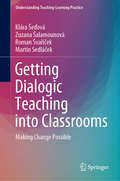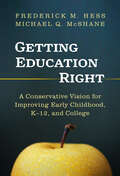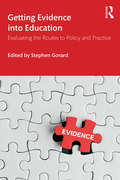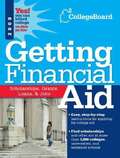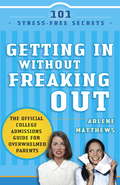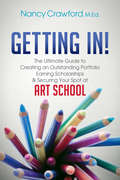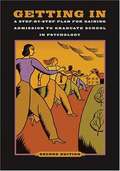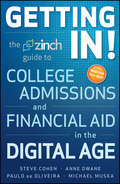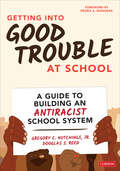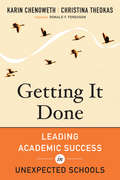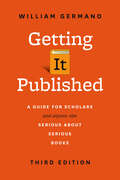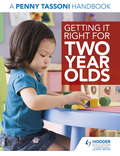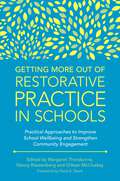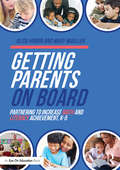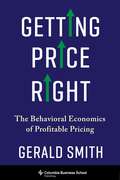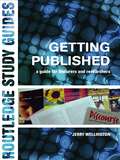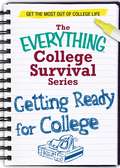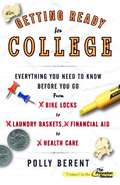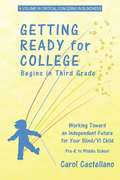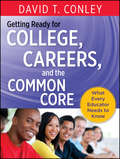- Table View
- List View
Getting Dialogic Teaching into Classrooms: Making Change Possible (Understanding Teaching-Learning Practice)
by Klára Šeďová Zuzana Šalamounová Roman Švaříček Martin SedláčekThis book contributes to our understanding how teachers can improve classroom dialogue and thereby boost student learning.The book reports the results of intervention research based on professional development program for teacher. Participating teachers strived, with the help of the researchers, to instigate a rich and authentic dialogue in their classrooms. The data shows that teachers were able to change their talk and interaction patterns, and this was followed by a desirable change in their students who started to talk more and expressed more complex thoughts.The book not only reports on a successful intervention, but most importantly investigates in depth the teacher experiences and ways of learning during the intervention project.
Getting Education Right: A Conservative Vision for Improving Early Childhood, K12, and College
by Frederick M. Hess and Michael Q. McShaneIn Getting Education Right, Rick Hess and Mike McShane argue that America has too long suffered from the absence of a robust, coherent, and principled conservative vision for educational improvement. The book both diagnoses a problem and offers a solution. The problem? The right has too narrowly focused on school choice, campus speech, and shrinking Washington’s footprint, while the left has sought to subsidize and supersize the status quo. The solution? An education system imbued with shared values, respectful of family ties, and equipped for the challenges of the 21st century. Rooted in fundamental conservative principles, the book explains both how we got here and where we need to go when it comes to early childhood, K–12, and higher education. Eschewing performative polemics, this book offers a field guide to bringing education back to its formative mission. Readers from across the ideological spectrum will benefit from engaging with the provocative analysis Hess and McShane offer, whether or not they agree with the policies they propose. Education is the foundation on which America’s future will be constructed, and Getting Education Right provides a timely blueprint for that project.
Getting Evidence into Education: Evaluating the Routes to Policy and Practice
by Stephen GorardWorldwide, there has been considerable progress in the quality of research evidence generated for use in education, but not the equivalent growth in knowledge of how best to get this evidence into actual use. Yet with far-reaching implications, all of education is damaged when persuasive but poor-quality evidence has widespread influence, or good research lies unused. Focused on the work of the Durham University Evidence Centre for Education, Getting Evidence into Education addresses this problem, examining what can be done to improve the take-up of suitable research evidence and inform the public service of education. Containing a variety of case studies, from evidence-based policies for early childhood education in Brazil, to the use of evidence on contextualized admissions to Scottish universities, the volume explores a variety of different ways to approach the problem, addressing the questions: What is the existing evidence on different approaches to getting research evidence into use? What are the factors which influence the uptake of high-quality research evidence by policy or practice? Which are the most effective pathways for evidence-into-use in particular contexts? Considering both the practical and ethical implications, the book builds towards key recommendations for the research community, practitioner bodies and policy-makers and advisors, directing them on how to communicate better with each other for the benefit of everyone.
Getting Financial Aid 2009 (3rd edition)
by College BoardThis simple, step-by-step guide explains how to get financial aid and gives the financial aid picture for each of the 3,000 colleges, universities, and technical schools included.
Getting In without Freaking Out: The Official College Admissions Guide for Overwhelmed Parents
by Arlene MatthewsIs College Planning Driving You Crazy? Somehow, watching as your children decide which schools to apply to is as stressful for you as it is for them. If you've found yourself contemplating essay forgery, scheduling five college tours for a single holiday weekend, and obsessively checking the U. S. News and World Report rankings, you may be on the verge of freaking out. But as a parent, it's important to (try to) remain calm and help keep everything in perspective. Written specifically for parents and their college-bound teens, Getting In Without Freaking Out is an insider's guide to the application process by professional college coach Arlene Matthews. Years of experience have taught her the secrets of playing the admissions game without all the anxiety. Now, Arlene shares what admissions officers won't tell you--that getting into a great college isn't as hard as it seems! You'll learn . . . * How to get into a top college without ever taking the SATs * Why a little procrastination never hurt anyone * Why applying to fewer schools increases the chances of acceptance * What really matters when your child goes off to college--and beyond As entertaining as it is practical and realistic, Getting In Without Freaking Out is the only guide of its kind--one that helps you get through the getting-in process with grace, good humor, and knowledge that will enhance your student's chance of success. From the Trade Paperback edition.
Getting In!: The Ultimate Guide to Creating an Outstanding Portfolio, Earning Scholarships & Securing Your Spot at Art School
by Nancy CrawfordGetting In! demystifies the process of how to get accepted to the world&’s leading art schools, thrive while you are there, and earn scholarships to fund your education. Getting In! outlines an in-depth process of how to ignite your creativity, create an outstanding portfolio of powerful and authentic works of art and design, and enhance your vitality and energy for creating. Getting In! will also enable you to identify and break through your creative blocks and procrastination. Getting In! is thorough in scope and depth, resulting in a creative experience that provides meaning, challenge, excitement, connection, joy, and success!
Getting In: A Step-by-Step Plan For Gaining Admission to Graduate School In Psychology (Second Edition)
by American Psychological AssociationGetting In, Second Edition is an update of the American Psychological Associations essential resource for anyone considering graduate study in psychology. This handy, readable book simplifies the process for applicants and increases their chances of being accepted. Useful timelines, tips, and tools break the tasks into manageable steps and help readers define their goals, select programs, and navigate the application process. A monthly timetable and detailed worksheets for selecting the best program matches are included, and a resource section provides a list of publications and organizations that are useful in the various phases of applying. Readers will learn what criteria admissions committees use to evaluate applicants, how to improve their qualifications, and how to showcase their talents in personal essays, letters of recommendations, and preselection interviews. The costs of a graduate education and financial aid information specific to graduate students are also discussed. Members of special populations, such as women, ethnic minorities, gay and lesbian applicants, and applicants with disabilities will find resources and guidance particular to their needs. While applying to graduate school can be challenging, this book demystifies the process and allays students concerns about how to tackle it.
Getting In: The Zinch Guide to College Admissions & Financial Aid in the Digital Age
by Steve Cohen Michael Muska Anne Dwane Paulo De OliveiraFrom the college admissions experts--where to go, how to get in, and how to pay for itZinch.com is the largest online social network connecting students with colleges and scholarship opportunities. With 2.5 million student profiles and more than 800 universities--from Yale to Stanford, and American University to community colleges--Zinch offers students an efficient, relevant, and effective way to find the "right- fit" school, how to get in, and how to pay for it.Getting In: The Zinch Guide to College Admissions & Financial Aid in the Digital Age is your college admissions how-to guide, written by experts with insider guidance to the entire college admission process. Leveraging the power of Zinch.com, it covers every aspect of the college application process, from choosing the right (vs.best) schools, visiting campuses, improving your odds with a dynamic application strategy, meeting with a college advisor, working with athletic recruiting, applying for financial aid, knowing what to do if you are on a wait list, and much more.Incredibly well-connected authorsLeverages the power of Zinch.com, the largest online social network of its kindApplication do's and don'tsIf you are one of the 2.2 million high school seniors ready to embark on the next step in your education, Getting In: The Zinch Guide to College Admissions & Financial Aid in the Digital Age is your go-to guide for getting into the college of your dreams--without ever breaking a sweat.
Getting Into Good Trouble at School: A Guide to Building an Antiracist School System
by Douglas S. Reed Gregory C. HutchingsTurn the promise of equitable education into reality. This is your guidebook for building an antiracist school. Written by two education leaders with very different life experiences, Getting into Good Trouble At School provides the context, empowerment, and concrete actions needed to dismantle racist policies and practices that for decades have kept students of color from experiencing the same success as their white counterparts. The journeys of Gregory Hutchings and Douglas Reed – which include systemic racism and white privilege - provide a unique model superintendents, principals, school board members and other educators can use to reimagine educational equity, actively dismantle institutional racism, and implement strategic, methodical policies that benefit the entire school community. In this book you’ll find A detailed case study of antiracist educational transformation What it really means to commit to racial equity Guidance for dismantling tracking and in-school segregation Positive, equitable alternatives to typical disciplinary practices Six steps to building an antiracist school system Racism isn’t always intentional. Antiracism, on the other hand, must be. Now antiracist education leaders can put their intentions into action—and grant the promise of an equitable and culturally rich education to all students.
Getting Into Good Trouble at School: A Guide to Building an Antiracist School System
by Douglas S. Reed Gregory C. HutchingsTurn the promise of equitable education into reality. This is your guidebook for building an antiracist school. Written by two education leaders with very different life experiences, Getting into Good Trouble At School provides the context, empowerment, and concrete actions needed to dismantle racist policies and practices that for decades have kept students of color from experiencing the same success as their white counterparts. The journeys of Gregory Hutchings and Douglas Reed – which include systemic racism and white privilege - provide a unique model superintendents, principals, school board members and other educators can use to reimagine educational equity, actively dismantle institutional racism, and implement strategic, methodical policies that benefit the entire school community. In this book you’ll find A detailed case study of antiracist educational transformation What it really means to commit to racial equity Guidance for dismantling tracking and in-school segregation Positive, equitable alternatives to typical disciplinary practices Six steps to building an antiracist school system Racism isn’t always intentional. Antiracism, on the other hand, must be. Now antiracist education leaders can put their intentions into action—and grant the promise of an equitable and culturally rich education to all students.
Getting It Done: Leading Academic Success in Unexpected Schools
by Karin Chenoweth Ronald F Ferguson Christina Theokas"Getting It Done describes in clear and helpful detail what leaders of successful high-poverty and high-minority schools have done to promote and sustain student achievement. It follows two celebrated books by Karin Chenoweth: "It's Being Done," which established that the work of educating all children is possible, and How It's Being Done, which examined the structures and processes necessary to support academic success. Getting It Done turns to the crucial issue of school leadership, exploring how school leaders have promoted unprecedented levels of school and student achievement. A book that focuses on real leaders--and on the knowledge and skills that they have employed on behalf of heightened achievement--Getting It Done will be essential reading for school leaders, and for all who believe that a successful education can be attained by all students."
Getting It Done: Leading Academic Success in Unexpected Schools
by Karin Chenoweth Christina Theokas"Getting It Done describes in clear and helpful detail what leaders of successful high-poverty and high-minority schools have done to promote and sustain student achievement. It follows two celebrated books by Karin Chenoweth: &“It&’s Being Done,&” which established that the work of educating all children is possible, and How It&’s Being Done, which examined the structures and processes necessary to support academic success. Getting It Done turns to the crucial issue of school leadership, exploring how school leaders have promoted unprecedented levels of school and student achievement. A book that focuses on real leaders—and on the knowledge and skills that they have employed on behalf of heightened achievement—Getting It Done will be essential reading for school leaders, and for all who believe that a successful education can be attained by all students."
Getting It Published: A Guide for Scholars and Anyone Else Serious about Serious Books, Third Edition (Chicago Guides to Writing, Editing, and Publishing)
by William GermanoFor more than a decade, writers have turned to William Germano for his insider’s take on navigating the world of scholarly publishing. A professor, author, and thirty-year veteran of the book industry, Germano knows what editors want and what writers need to know to get their work published. Today there are more ways to publish than ever, and more challenges to traditional publishing. This ever-evolving landscape brings more confusion for authors trying to understand their options. The third edition of Getting It Published offers the clear, practicable guidance on choosing the best path to publication that has made it a trusted resource, now updated to include discussions of current best practices for submitting a proposal, of the advantages and drawbacks of digital publishing, and tips for authors publishing textbooks and in open-access environments. Germano argues that it’s not enough for authors to write well—they also need to write with an audience in mind. He provides valuable guidance on developing a compelling book proposal, finding the right publisher, evaluating a contract, negotiating the production process, and, finally, emerging as a published author. “This endlessly useful and expansive guide is every academic’s pocket Wikipedia: a timely, relevant, and ready resource on scholarly publishing, from the traditional monograph to the digital e-book. I regularly share it, teach it, and consult it myself, whenever I have a question on titling a chapter, securing a permission, or negotiating a contract. Professional advice simply does not get any savvier than this pitch-perfect manual on how to think like a publisher.”—Diana Fuss, Princeton University
Getting It Right for Two Year Olds
by Penny TassoniLearn how to meet the needs of two year olds with this indispensable guide by Penny Tassoni which is ideal for both early years settings and students. Written by the leading author in Childcare and Early Years education, this is a complete guide to working with this age group. It looks in detail at two year olds' development in each of the prime areas of learning and provides advice on how best to plan activities, organise provision and create stimulating environments. It is also a typical Tassoni book: fun, informative and practical! - Pinpoints two year olds' development across the prime areas of learning: Personal, Social and Emotional development, Physical development and Communication and Language - Provides guidance on how to carry out the two year old progress check and work with parents and other professionals to support development - Includes practical tips on overcoming tantrums, fussy eating and other challenges associated with this age group -Explains the specific play needs of two year olds - Includes activities linked to the EYFS which focus on each of the prime areas.
Getting MORE Excited About USING Data
by Edie L. HolcombPut data to WORK to better meet the needs of all students Have you become hyper-focused on state tests? Do you have important data collected, warehoused, and gathering dust? The time has come to dust off that data and put it to work for your students. The new reporting requirements under ESSA, combined with the flexibility to act on that data, provide a huge opportunity for education leaders. This is your opportunity to rebuild data processes and rekindle excitement about using data for school and student growth. Getting MORE Excited About USING Data addresses both cultural and technical aspects of using data, starting with underlying beliefs about students, assessment, and individual and collective teacher efficacy. This updated edition features: Guiding questions and protocols for effective professional learning communities, shared leadership teams and subject/grade teaching teams New material on the use of formative assessment in schoolwide planning and instructional design Renewed focus on the role of students Tips on the electronic challenges of storage, retrieval, privacy and security Real-life examples from schools and districts ranging from specific data displays to sustained, long-term change The straightforward language, adaptable models, and focus on human elements make Getting MORE Excited about USING Data an essential resource for every leader. The time is now to use data to establish a collaborative culture with student success at its core. "Holcomb leads educators to use data as a catalyst to foster their passion for continuous learning, I highly recommend her pragmatic approach in looking at data as a means to stir the hearts and minds of educators for the sake of our future human resources: the students we serve." Kathy Larson, Author Coaching for Infinite Results "This book is full of practical supports, resources, and illustrations. It is well grounded in the work of schools and the importance of data to that mission." Megan Tschannen-Moran, Professor of Educational Leadership College of William & Mary, Williamsburg, VA
Getting MORE Excited About USING Data
by Edie L. HolcombPut data to WORK to better meet the needs of all students Have you become hyper-focused on state tests? Do you have important data collected, warehoused, and gathering dust? The time has come to dust off that data and put it to work for your students. The new reporting requirements under ESSA, combined with the flexibility to act on that data, provide a huge opportunity for education leaders. This is your opportunity to rebuild data processes and rekindle excitement about using data for school and student growth. Getting MORE Excited About USING Data addresses both cultural and technical aspects of using data, starting with underlying beliefs about students, assessment, and individual and collective teacher efficacy. This updated edition features: Guiding questions and protocols for effective professional learning communities, shared leadership teams and subject/grade teaching teams New material on the use of formative assessment in schoolwide planning and instructional design Renewed focus on the role of students Tips on the electronic challenges of storage, retrieval, privacy and security Real-life examples from schools and districts ranging from specific data displays to sustained, long-term change The straightforward language, adaptable models, and focus on human elements make Getting MORE Excited about USING Data an essential resource for every leader. The time is now to use data to establish a collaborative culture with student success at its core. "Holcomb leads educators to use data as a catalyst to foster their passion for continuous learning, I highly recommend her pragmatic approach in looking at data as a means to stir the hearts and minds of educators for the sake of our future human resources: the students we serve." Kathy Larson, Author Coaching for Infinite Results "This book is full of practical supports, resources, and illustrations. It is well grounded in the work of schools and the importance of data to that mission." Megan Tschannen-Moran, Professor of Educational Leadership College of William & Mary, Williamsburg, VA
Getting More Out of Restorative Practice in Schools: Practical Approaches to Improve School Wellbeing and Strengthen Community Engagement
by Michael Friedman Margaret Thorsborne Nancy Riestenberg Jim McGrath Beverley Turner Gillean McCluskey Fania Davis Sue Attrill Carole Edgerton Lyndsay Broadfoot Samia Farooq Sharon Fitzpatrick Kerri Berkowitz Cindy Zwicky David Yusem Terence Bevington Katie Cebula Annie O’Shaughnessy Denise Quinlan Anna Gregory Nathan Wallis Sara Davis Julia Hennessy Nici NixonRestorative practice (RP) has been successfully implemented in schools for decades and is primarily associated with improving behaviour and relationships, by changing the culture of problem solving in the school. However, it has huge untapped potential to support initiatives in other areas, and this book provides examples of how RP can enhance the effectiveness of these other practices.Split into three sections, the book first looks at implementation, readiness and evaluation. It then covers integrating RP with, and linking RP into, other issues relevant to schools such as trauma, poverty, and mindfulness, and finally shows how to work well with parents and families. The book gives proven strategies for measuring success and evaluating effectiveness. Overall, it provides insight into a variety of issues RP can help schools with, and addresses them in practical ways to help schools implement restorative practice to its full potential.
Getting Parents on Board: Partnering to Increase Math and Literacy Achievement, K–5
by Alisa Hindin Mary MuellerLearn how to work more effectively with K–5 parents to increase student achievement in math and literacy. Research shows that parent involvement in schools leads to higher test scores and more engaged and enthusiastic students, but it isn’t always easy for teachers to bridge the gap between the home and the school. This insightful book provides helpful, research-based strategies to foster meaningful home–school partnerships and overcome the challenges teachers often face when trying to build relationships with parents. You’ll learn new ways to: Promote parent involvement at home and school; Share specific math and literacy strategies with parents to reinforce children’s learning; Plan and organize effective parent conferences that foster true dialogue about a child’s education; Communicate with parents about what you’re teaching and how you’re teaching it, so they can actively contribute to their child’s learning at home; Develop family nights and workshops to get parents involved in learning at school; Recommend games, activities, and projects that parents can use at home to help their children practice math and literacy skills; And much more! Each chapter is full of practical tools such as Common Core-aligned strategies, useful resources for parents, and sample parent letters that you can use to increase and improve your home–school communications. Bonus: Additional parent letters on a variety of topics are available on our website, www.routledge.com/ 9781138998698, to help you keep parents connected throughout the year.
Getting Price Right: The Behavioral Economics of Profitable Pricing
by Dr. Gerald SmithHow do leaders, managers, and proprietors go about the essential task of setting prices? What biases enter into this process, and why? How can a business debias its price setting to become more productive, strategic, and profitable?Combining perceptive insights from behavioral economics with leading-edge ideas on price management, this book offers a new approach to pricing. Gerald Smith demonstrates why understanding, reframing, and refining everyday pricing processes—a firm’s or manager’s pricing orientation—results in a better long-term pricing strategy. He explores how pricing actually happens in practice and shows how to identify and remove the psychological blinders that cause suboptimal decisions and policies. Smith details how to improve pricing orientation by combining the soft behavioral skills that intuitively shape and refine pricing practice with the hard analytic skills that guide and structure pricing strategy. The result is more rational and more profitable pricing—with respect to not only revenue and profitability but also employee productivity and customer satisfaction.Offering an accessible and actionable model, Getting Price Right is the first book to apply behavioral economics to managerial price setting. It is a must-read for corporate business leaders, thought leaders, and professionals interested in advances in pricing and for managers, entrepreneurs, proprietors, and small and midsize business owners whose everyday work involves pricing.
Getting Published: A Guide for Lecturers and Researchers
by Jerry WellingtonThis handy guide for new and practising lecturers and researchers takes a rare insider's look at the activities of writing and publishing. Turning the spotlight inwards, it examines how and why professionals communicate with each other through writing and publishing.Written with great verve and pace, the author succeeds in providing sensible advice bolstered by many illustrative examples, case studies and anecdotes. For the academic needing insight into the serious business of getting published, this book will provide answers to many of their frequent questions:* Why do they write and publish?* Who are they writing for?* What channels of communication are available for their writing?* Who 'controls' these channels?* How can they successfully submit articles and papers to journals and newspapers, contribute chapters to books, or approach publishers with book proposals?Developed from a series of seminars on the subject by the author, this book will be an enjoyable and informative guide to anyone with an interest in getting their work published.
Getting Ready for College
by Adams MediaGet ready for the best years of your life!College Survival - Getting Ready for College contains everything you need to know about preparing for the next few years. With advice from deciding what to bring to your dorm room to the pitfalls of credit cards to the thrills of living on your own for the first time, you'll be big man (or woman) on campus in no time.
Getting Ready for College
by Polly BerentGetting Ready for Collegeis the ultimate easy-to-use guide to success for college-bound seniors, first-years, and their parents. Polly Berent answers the questions you didn’t know you would need to ask: • What’s the deal on financial aid and cash management? • Should I bring a flashlight to school? Do I really need a microwave and a vacuum cleaner? • Should I call Mom every time I’m homesick? Will my boyfriend/girlfriend wait for me? • Will having a credit card help me? Do I need quarters for the laund...
Getting Ready for College Begins in Third Grade: Working Toward an Independent Future for Your Blind/Visually Impaired Child (Critical Concerns in Blindness)
by Carol CastellanoAll parents hope for an independent future for their blindvisually impaired child. To turn that hope into a reality, parents need to understand the scope of skill development that must be addressed, along with the importance of equal expectations for the child's development, proper training, and opportunity to practice and develop skills. But what if expectations are low, training in blindness skills is scanty or even absent, and overprotection prevents the blindVI child from learning and practicing skills? The idea of an independent future can remain a distant dream. The purpose of this book is to guide parents and teachers in fostering the blindvisually impaired child's skill development in such critical areas as academics, independent movement and travel, social interaction, daily living, and self-advocacy, so that he or she will truly be on the road to an independent future. A practical, easy to use guide, written in plain English, the book warns about common problem areas and provides ideas for getting and keeping the child's education and development on track. It highlights the interplay between skills and competence, confidence, self-respect, and the respect of others. Of the small number of books and videos available on the subject, most were written by professionals in the field and many begin with the supposition that blindness is at best sad and at worst tragic. Few --maybe none --have the ardent passion for independence that the parent of a blindvisually impaired child brings to the subject. Instead of overwhelming parents and teachers with the difficulty of the undertaking before them, Getting Ready for College Begins in Third Grade will inspire their confidence and enthusiasm for the task at hand.
Getting Ready for College, Careers, and the Common Core
by David T. ConleyCreate programs that prepare students for college, careers, and the new and challenging assessments of the Common Core State Standards Written for all educators but with an emphasis on those at the secondary level, this important resource shows how to develop programs that truly prepare students for both the Common Core assessments and for college and career readiness. Based on multiple research studies conducted by Conley as well as experience he has gained from working with dozens of high schools that succeed with a wide range of students, the book provides specific strategies for teaching the CCSS in ways that improve readiness for college and careers for the full range of students. Draws from research-based models for creating programs for high school students that will ensure readiness for tests and for college and beyond Includes strategies and practices for teachers to help students develop postsecondary preparedness Is the third in a series of books on readiness written by David Conley, including College Knowledge and College and Career Ready Teachers can use this valuable resource to understand the "big picture" behind the Common Core State Standards, how to teach to them in ways that prepare students for new, challenging assessments being implemented over the next few years and, more importantly, how to help all students be ready for learning beyond high school.
Getting Ready for College: Get the most out of college life
by Adams MediaGet ready for the best years of your life!College Survival - Getting Ready for College contains everything you need to know about preparing for the next few years. With advice from deciding what to bring to your dorm room to the pitfalls of credit cards to the thrills of living on your own for the first time, you’ll be big man (or woman) on campus in no time.
